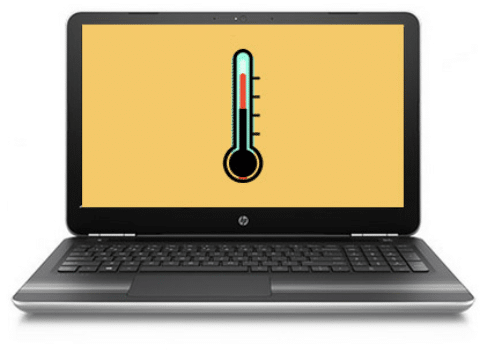What to Do if Your Laptop is Overheating: Prevention and Solutions
Laptop Overheating Problem: Did you know that laptop burn is a real condition? An overheating laptop can cause more harm than you may have initially thought, so it’s best to prevent or rectify the situation as soon as possible. Laptop overheating is quite a common occurrence, though, and it happens with almost all laptop brands from Dell to HP, MAC, ASUS, and MSI.
If your laptop is overheating, you must have plenty of questions, like why it’s overheating and what you can do to prevent or solve the issue. Well, in this post, we’ll take you through a step-by-step guide about laptop overheating and everything you need to know to take care of your laptop.
Table of Contents
Why Is Your Laptop Overheating?
All laptops are prone to overheating because, unlike desktops, their components are designed in very close proximity. In recent years, manufacturers have felt the need to create smaller, thinner, faster, lighter, and more powerful laptops. This makes them incredibly attractive but compact and increasingly fragile as well.
For them to achieve this goal, they reform and embed components into chips and transistors. The dense package causes overheating when the laptop is in operation, and the increase in speed processors, high graphics cards, and dust and debris for older laptops make the overheating all the more intense.
If the fan or any other component overworks, it leads to overheating, which can easily destroy your laptop and damage hardware and software.
The Symptoms of an Overheating Laptop
The fact of the matter is all laptops heat up the minute you start them. However, what’s the difference between normal heat and overheating? Some of the symptoms of an overheating laptop include:
- A fan making loud whirring noises
- If it’s struggling to perform basic tasks
- Error messages mysteriously popping up in random programs.
- The blue screen of death (BSOD)
- If the laptop shuts down on its own
- Lines showing up on the screen which is a sign of an overheating video card
- Some parts of the laptop are very hot, especially where the processor and battery are located.
If your laptop has multiple of these symptoms, then you can be sure it is overheating. If it’s just one of them, then it could be a different issue like slow or outdated software. You can also use a laptop temperature monitor to gauge how hot your laptop is.
Top Things That Cause Overheating
Basically, there are three primary causes of overheating, which are prolonged usage, insufficient cooling, and running multiple programs at a time.
You can avoid these by shutting your laptop down when not in use, running only a few applications at a time, and making sure the fan is in good condition at all times. Also, avoid running gaming software on a business laptop as it’ll cause overheating due to the enormous amounts of energy required.
Dangers of an Overheating Laptop
Sometimes overheating may seem like a regular thing, but it can have dire consequences on your internal hardware such as the hard drive and the battery. When the laptop is running at a high temperature, it will destroy components, including your motherboard, memory modules, and video cards.
These damages can resolve other consequences such as drive corruption, data loss, system crash, file corruption, frequent system freeze, and hard drive failure.
You may also notice unexpected system shutdown, clicking sounds, constant screeching, and much more. This will ultimately decrease the lifespan of your laptop, so it’s advisable for you to take measures to prevent these issues altogether.
8 Ways to Prevent and Fix Laptop Overheating
Most laptop overheating issues are caused by hardware problems. For this reason, you may have to take it apart to rectify some issues. If you can’t, it’s advisable to take it to a professional repair shop to have it fixed. Here is a step-by-step guide to help you through this.
1. Place the Laptop on Hard Surfaces at All Times
You may not know this, but it’s not okay for you to place your laptop on uneven surfaces. Your bed, pillow, lap, or sofa are all uneven surfaces that may obstruct its airflow.
It’s advisable to use your laptop on a flat surface where the airflow can’t be blocked. If you don’t want to sit at a desk all the time, then place the laptop on a lap-stand or a laptop holder that’s hard and flat.
2. Invest in a Laptop Cooling Pad
Have you ever thought of getting a laptop cooling pad? It may seem like an unnecessary gadget, but it can do a lot of good for your laptop. The trick is in getting the right cooling pad because some can cause more damage than good.
It’s important for you to understand your laptop’s airflow before you choose the right pad. You see, most laptops suck air from the bottom. When you get a cooling pad that sits underneath the laptop and sucks air away from it, it will contribute to overheating and not cooling.
If the intake grills of your laptop are located at the bottom, you should get a cooling pad that blows air upwards into the laptop. Alternatively, you can get a cooler that only absorbs heat.
3. Check the Heat Source
To fix an overheating laptop, the first thing you have to do is find the heat source. You first need to check the heat transfer and internal airflow. Every laptop has a vent that allows in cool air and expels hot air. If the vent is obstructed, there’s bound to be a problem with heat transfer, which results in laptop overheating.
Check where your vents are located, then place your hand on top of them to check the pressure of the airflow. If you don’t feel any pressure, then chances are there’s a problem. If the vents are not the problem, it may be coming from the fan, so you need to check that the fan is not clogged up by dirt and debris or if it needs repairing you must go to laptop repairing center as soon as possible .
4. Clean the Internal Cooling System
One of the most important parts of your laptop to look at if it’s overheating is the cooling fan. It was designed and positioned in the right place to cool your graphics card and the CPU. Over time, you can expect the cooling fan to accumulate layers of dust, which will undoubtedly slow it down because it will block airflow.
If you can, read through your laptop’s manuals and learn how to open it to access the fan and clean it out. Before you attempt to do this, turn off your laptop, remove the battery, unplug your power strips, and stay isolated. Once you manage to open it up, clean the fan with a cotton swab dipped in alcohol, and ensure the alcohol is completely evaporated before turning your laptop back on.
It’s also advisable to use a blower or a vacuum cleaner to get rid of all that dirt and dust clogging your laptop. Make sure you hold down the fan to keep it from spinning when you do this to avoid spinning in the wrong direction, which could cause additional problems.
5. Check Whether Your Battery Is Dying
Different laptops have different batteries that come with different maintenance needs and lifespans. However, as necessary as they are, they cause laptop overheating problems as well, especially if charged to 100%. A lot of people make it a habit to keep the charger in despite the laptop being idle.
If you do this, understand that it’ll reduce your battery life, minimize efficiency, and eventually die out. Before this happens, it will generate a lot of heat and cause the rest of your laptop to overheat. If this is the problem, you need to get rid of the laptop battery and get a new one or go looking at laptops to get a better one.
6. Remove and Apply New Thermal Paste
Dried thermal paste could be the reason why your CPU is overheating, which would, in turn, cause other components to overheat as well. If possible, remove the old thermal paste using high-percentage rubbing alcohol or a dedicated cleaner.
Let the alcohol sit for a few minutes to break up the grease, then use earbuds to clean it out thoroughly. Buy a recommended thermal paste and apply a tiny blob on the CPU, and spread it out evenly.
7. Clean the Rest of the Hardware
If, after all this, your laptop is still overheating, you may have to check how dusty your hard drive it and clean it out. Dusty hard drives can cause major laptop problems, including data loss, so you need to make sure that it’s clean at all time. If you are not in a position to do this, it’s advisable for you to take it to a professional laptop technician to have it fully cleaned up.
8. Decrease Your Load
If you notice that the laptop overheating problem is not caused by hardware, it’s time for you to perform some tricks with the software. For starters, loading too many tasks at the same time can increase the CPU temperature.
Run your Windows task manager to gauge what apps are using more CPU memory and limit apps that automatically start when you start your laptop. Avoid running too many programs at the same time to avoid the laptop overheating.
Conclusion
There you have it! This is your ultimate guide on preventing laptop overheating and fixing the issue that’s plaguing you already. Take each step at a time to figure out what’s causing overheating and troubleshoot accordingly. If all fails, take your laptop to a professional laptop repairing center to have it checked out.
For more insightful posts about technology, please check out our blog section.
Follow Us On:

